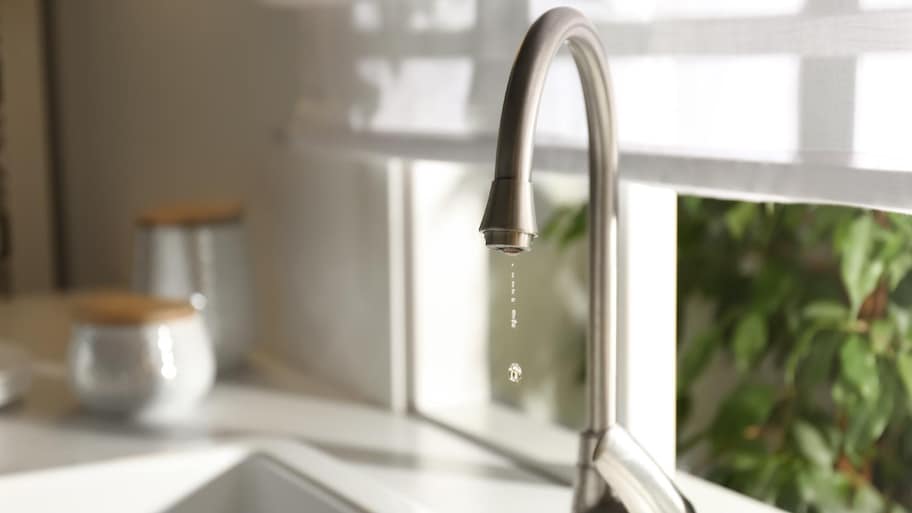How to Fix a Leaky Faucet
Follow these steps to defeat the drip of a leaky faucet


Drip, drip, drip—those might as well be the “cha-chings” of your water bill slowly going up. A leaky bathroom or kitchen faucet is frustrating enough, but the extra expense adds insult to injury. Fret not, though, and don’t dial the plumber’s number just yet. With a few supplies and basic tools, you can likely tackle this repair on your own.
Why Is My Faucet Leaking?
Unfortunately, there are several common causes of kitchen or bathroom faucet leaks. Faucets feature many moving parts; if any of them wear out or malfunction, you could have a leak on your hands.
Some of the most common culprits of dripping faucets are loose screws, washer problems, and corroded o-rings or valve seats. Once you discover the reason for the leak, you’ll need to determine whether to repair or replace the faucet with the help of a plumbing professional.
How to Fix a Leaky Faucet
Now it’s time to stop that leaky faucet from dripping. Check out the following methods for repairing different types of leaky faucets.
Identify Your Faucet Type
Before you begin, you must identify what kind of faucet you have. There are four types of faucets that fall into two basic categories: washer and washerless. Compression faucets are the only washer type, while the other three (cartridge, ceramic disk, and ball) are washerless. Here’s how to determine which type you have.
Consider where your faucet is located. Ball faucets are common in kitchen sinks, for example.
Inspect your faucet for washers. Some faucets have washers, while others are washerless. Washer faucets are always compression faucets.
Count the number of handles. Cartridge faucets are the only washerless faucets that have two handles.
Look at the manufacturer’s information. If you still have your instruction manual or packaging, you should be able to look up the type of faucet.
Fix a Leaky Compression (Washer) Faucet
A compression faucet is a double-handled faucet that allows you to control water flow by turning the handles clockwise or counterclockwise. This “compresses” a neoprene or rubber washer, creating (or releasing) a watertight seal. Activating these requires a bit of elbow grease, as the compression mechanism needs pressure to work. Due to the inevitable breakdown of its flexible material, the washer is often to blame when this type of faucet leaks.
Here's how to repair a leaky compression faucet:
Turn off the water shut-off valves. Locate the valves—check right below the sink basin and near the back wall—and turn them clockwise until fully tightened. If this isn’t an option, you can also shut off the water main.
Drain the faucet of any leftover water before starting the repair process.
Plug the drain with a stopper or a rag.
Use a screwdriver to loosen the screws and remove the handles from the faucet.
Use a wrench to remove the nut and expose the stem, which sits atop the seat washer.
Pull out the stem to expose the O-ring, which will be thinner than the seat washer.
If the leak was coming from the faucet’s handles, examine the O-ring and find a replacement at the hardware store if needed.
Remove the washer, which is typically held in place by an upside-down screw.
Take the old washer to the hardware store to find an exact replacement.
Coat the new washer in plumber’s grease before replacing it.
Reassemble the parts.
Fix a Leaky Ball Faucet
A popular option for kitchen sinks, ball faucets are single-handled with a “ball” joint that rotates in all directions and controls water temperature and pressure. The internal ball has slots, which control the mixing of cold and hot water. Although these aren’t as prone to leaks as compression faucets, their moving parts tend to give way over time.
For ball faucets, the repair method depends on where the leak is coming from. If the base of your faucet leaks, try this repair tactic.
Turn off the water shut-off valves. Locate the valves—check right below the sink basin and near the back wall—and turn them clockwise until fully tightened. If this isn’t an option, you can also shut off the water main.
Drain the faucet of any leftover water before starting the repair process.
Plug the drain with a stopper or a rag.
Find the set screw on the underside of the handle and loosen it with an Allen wrench until you can lift off the handle.
Use a spanner wrench to tighten the collar, working clockwise.
Replace the handle and turn the water back on to test for leaks.
If that doesn’t work, shut off the water again and remove the handle.
Remove the spout to examine the O-rings.
Pry out any worn O-rings with the hook of the spanner wrench.
Find replacement O-rings in the repair kit and coat these in heatproof plumber’s grease.
Put the new O-rings in place using the spanner wrench.
Replace the spout and handle.
Turn on the water and test for leaks.
Fix a Leaky Cartridge Faucet
Cartridge faucets can be single- or double-handled, with a cylindrical metal “cartridge” that moves to open or cover holes, starting and stopping the water flow respectively. This cartridge also rotates to control the water temperature. Two-handled cartridge faucets can look like compression faucets, but they are much easier and smoother to turn since there is no “compression” mechanism to activate.
When there's a leak in your cartridge faucet, follow these steps to fix the leak:
Turn off the water shut-off valves. Locate the valves—check right below the sink basin and near the back wall—and turn them clockwise until fully tightened. If this isn’t an option, you can also shut off the water main.
Drain the faucet of any leftover water before starting the repair process.
Plug the drain with a stopper or a rag.
Remove the retaining clip with pliers if needed. This is the small, circular, threaded piece that holds the cartridge in place.
Pull the cartridge up to remove it. Note its position and orientation for when it’s time to put it back.
Use a small flathead screwdriver to remove the seat and seat spring.
Drop in the new seat spring.
Use your finger to push the new seat into place.
Spread plumber’s grease around the base of the cartridge.
Align the notches and push the cartridge back into the faucet.
Use a wrench to tighten the large retaining nut.
Replace the faucet handles.
Turn the water supply line on and test the faucet.
Fix a Leaky Ceramic Disk Faucet
A ceramic disk faucet is a single-handled faucet with the most modern, reliable design—the latest and greatest in faucet technology. It features a cylindrical body topped with a single lever that controls water flow and temperature. An inner chamber houses both cold and hot water, and two ceramic disks control the proportion of each. These disks have corresponding holes that match up as you turn the water from hot to cold, determining how the temperatures will mix.
The great thing about ceramic disk faucets is that they rarely, if ever, need repairs. Soaking the faucet parts in vinegar or calcium remover to remove buildup will usually solve any leaking issues. However, if anything goes wrong with the moving parts, you may need a local plumber to fix them. But before you do, try the following steps to fix a leaky ceramic disk faucet.
Turn off the water shut-off valves. Locate the valves—check right below the sink basin and near the back wall—and turn them clockwise until fully tightened. If this isn’t an option, you can also shut off the water main.
Drain the faucet of any leftover water before starting the repair process.
Plug the drain with a stopper or a rag.
Remove the dome-shaped escutcheon cap, which is right beneath the handle and typically made of metal.
Unscrew the disk cylinder and remove it.
Remove the round neoprene seals on the underside of the cylinder, using the tip of a flathead screwdriver if needed.
Soak the disk cylinder in calcium remover or white vinegar for several hours.
Replace the seals if they appear worn. Bring the old seals to the hardware store to find an exact match.
Rinse the disk cylinder and put the seals back into place.
Replace the cylinder and the faucet handle.
Turn the water supply line back on and gradually test the faucet.
Tips for Dealing With a Leaky Faucet
Keep these helpful tips in mind while you repair your leaky kitchen or bathroom faucet.
Keep a Bucket Handy
When making DIY repairs to a leaking faucet, it’s a good idea to keep an empty bucket underneath the sink to catch any water or debris that may leak out. That way, you can minimize the mess and make the clean-up process easier.
Check for Aerator Clogs
After completing the faucet repair process, you should run a quick test to ensure that your sink’s aerators aren't clogged. The aerator is the piece that screws onto the end of the faucet spout, and it can hinder water flow if blocked. The test is simple: Run hot and cold water for a few minutes to ensure it’s flowing smoothly. If your aerator is clogged, then you'll need to remove the faucet aerator and clear it out or replace it, depending on its condition.
Recognize When to Replace the Faucet
In some cases, your faucet issue may require you to replace it instead of repairing it. Luckily, DIY faucet replacement is relatively straightforward, and it should take about 5 hours to complete. If you don’t feel comfortable replacing the faucet on your own, hire a local plumber to get the job done.
How Much Does it Cost to Fix a Leaky Faucet?
The cost to repair a leaky faucet depends on whether you DIY the fix or hire a professional plumber near you to handle the job. On average, the price of hiring a plumber for a small job, such as fixing a faucet, ranges from $125 to $350. If you tackle the leaky faucet yourself, you’ll only need to pay for the appropriate tools and materials, which vary by the type of faucet and its issue.
DIY Vs. Hiring a Pro
If you invested a lot of cash in your faucet, or believe the leak is coming from a larger plumbing problem, contact a local plumbing repair technician. As with any DIY vs. hiring a pro dilemma, springing for a licensed professional will save you time and effort, as well as prevent any potential damage to your plumbing system.
Frequently Asked Questions
In most cases, a dripping faucet will not stop on its own. Dripping usually occurs because of a failed cartridge or broken washers. Normal wear and tear eventually runs these parts down and causes the faucet to drip when you've already shut off your sink. Replacing the cartridge or washer should fix the problem.
Deteriorated seals, O-rings, or gaskets are common culprits behind a leaky sink after you’ve turned off the water—especially if your sink is older than 15 years. Inspect each of these mechanisms in your sink for signs of corrosion or looseness, then replace the worn-out part to fix it. Older sinks may be worth replacing entirely if you have several worn-out parts on your sink.
If nothing is coming out of your faucet, then you could have frozen pipes, a clogged faucet, or your water supply could be shut off. First, check your shutoff valves. If it's a hot sunny day, then you can rule out frozen pipes and take a closer look at your aerator for signs of mineral deposits. Removing the aerator and cleaning it out can often return water flow. If temperatures are below freezing, then you may have frozen pipes. Knowing what to do when pipes freeze is important for unfreezing your pipes to prevent them from bursting.
